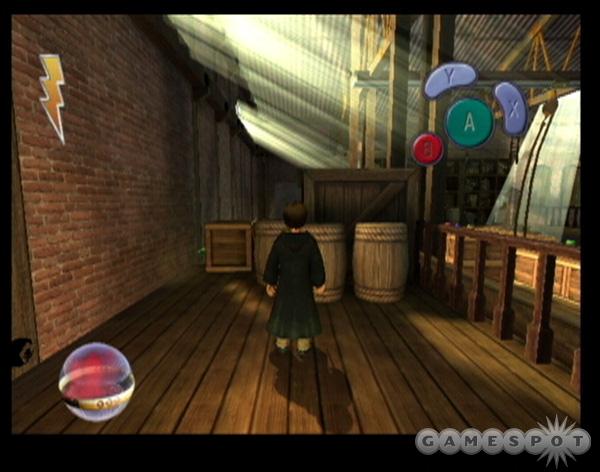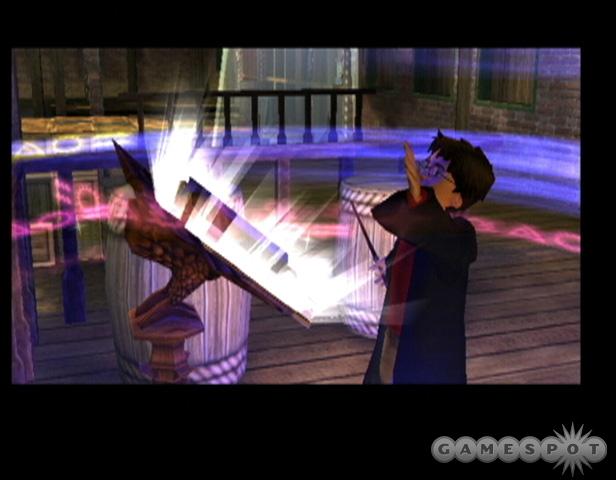Last year's Harry Potter and the Chamber of Secrets marked the first game based on the Harry Potter franchise to be targeted at a wider audience than the core children for whom the very first Harry Potter game for the original PlayStation was intended. The third-person action adventure game, developed by Eurocom, managed to offer a mix of good presentation and engaging gameplay while staying true to its source material. Nearly a year later, Electronic Arts is revisiting Harry's first adventure in a new multiplatform title, Harry Potter and the Sorcerer's Stone. The game, developed by EA's UK Studio in collaboration with veteran developer Warthog Games, borrows liberally from the Chamber of Secrets formula to make for a new adventure that retells young Mr. Potter's origins. While this may sound like a good idea on paper, the actual execution, unfortunately, doesn't live up to the standards of Chamber of Secrets and ends up being a lackluster game that never quite comes together.

The game's story sticks pretty close to the first book in author J.K. Rowling's juggernaut franchise and casts you in the role of young Harry as he starts his first year at Hogwart's School of Witchcraft and Wizardry. You'll hook up with Harry's circle of friends, meet his teachers, and, of course, sort out some trouble that's brewing at the school. The game follows a linear objective-based structure that is broken up into days. Each day features its own unique objectives (usually revolving around your classes at Hogwart's), which you'll have to clear before moving on to the next. Your activities are balanced between exploration, puzzle-solving (sometimes with the aid of your trusty owl Hedwig), and combat. However, once you've completed your daily tasks, you'll decide when your day is over, which lets you get in some exploration or minigame time if you need a change of pace. You'll find the same basic collectibles in Sorcerer's Stone that were in Chamber of Secrets, so plan on collecting Bertie Bott's every-flavored beans, which you can use to trade for items and wizard cards. At any rate, Harry's adventures will probably last you fewer than 10 hours.
Harry Potter and the Sorcerer's Stone offers a fair amount of gameplay variety and aims to make controlling Harry as user-friendly as possible. The control here is identical to last year's game, so you'll move Harry with the controller's analog stick, and you'll use the face buttons for context-sensitive actions and spells. Spellcasting lets you fire off a spell quickly, or you can charge your sorcery up a bit by holding down a spell's assigned face button for a set amount of time. You'll keep track of your collectibles in Harry's "remembral," which is an in-game menu that lets you stay on top of everything that goes on in the game. You'll use the shoulder buttons to target foes, and you'll also have limited control over the camera during specific areas in the game. Jumping occurs automatically when Harry runs toward a gap. If the jump is just short of his intended destination, he'll even catch ledges. As before, Harry will able to shimmy against walls in stealth sequences (like in Splinter Cell) and can fly on a broom when needed.
The graphics in Harry Potter and the Sorcerer's Stone fall a bit short of last year's game and ultimately fail to impress. Many of the art assets used in Sorcerer's Stone are back but haven't made a very smooth transition. You'll still find nicely constructed and detailed environments that re-create familiar areas, such as the Hogwart's school grounds and surrounding areas. (Apparently, this gave developer Warthog license to introduce some new nooks and crannies for Harry to explore.) The characters are represented by simple models that are modestly detailed but manage to look close enough to their cinematic counterparts. The game also features a good assortment of lighting and particle effects for magic, thus giving the visuals some flourish. However, the overall presentation is marred by glitches, like a finicky camera system that adds an unwelcome layer of difficulty to sequences--such as when you're trying to jump from platform to platform. Whereas last year's Chamber of Secrets game managed to offer a fairly smooth experience across the GameCube, PlayStation 2, and Xbox, Sorcerer's Stone is much more hit-or-miss, as it features inconsistent frame rates and what feels to be a general lack of polish and optimization for any of the versions. The GameCube and Xbox games do offer progressive scan support, which helps the visual quality of these incarnations somewhat but doesn't make any dramatic differences.

The game's audio is good, but it isn't terribly remarkable. You will hear decent voice acting for Harry and the colorful characters you'll encounter in the game. The audio is also available in Spanish, which is a nice bilingual touch. The voice gets a bit weaker when it comes out of the assorted foes you'll face, and your foes do tend to sound a bit generic. The sound package is rounded out by ambient noises and a good collection of effects used for Harry's spells, which are fine and are suitably magical-sounding. Of the three versions, the Xbox version's audio is the best, thanks to in-game Dolby Digital, which makes the experience a bit more immersive.
Overall, Harry Potter and the Sorcerer's Stone is a weak follow-up to Chamber of Secrets that seems like an awkward fit for anyone who already owns last year's game. While fans may enjoy the chance to relive Harry's first adventure in a proper action adventure game, the gameplay and graphical performance of Sorcerer's Stone doesn't differ much from Chamber of Secrets, and the game itself doesn't offer any dramatic improvements to make it a must-have. In the end Harry Potter and the Sorcerer's Stone is an unremarkable game that diehard fans may enjoy, but it's one that casual gamers and Potter fans may want to think twice about picking up.